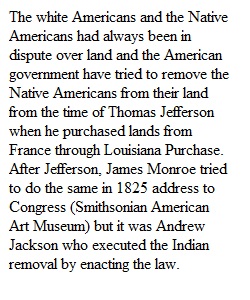


Q Critical Thinking Essay Instructions Answer the following question based on your textbook AND at least TWO ADDITIONAL SOURCES. Your observations should be typed, double spaced with correct spelling and proper sentence structure, and approximately two-to-six pages in length (500-1500 words). Your research must be reflected within the body of the paper via appropriate citations. A Works Cited of ALL the sources you consulted, including the textbook, should be included as part of the assignment, at the end of the reflective essay. Based on your research, answer the questions posed below, making sure to take a clear position on the final two question components. What was the purpose of the Indian Removal Act of 1830? What was the rationale given in 1830 for this Act? What were the short and long term results of this Act? Was the Indian Removal Act justified? Why or Why not? Given the impact of the Indian Removal Act on Native Americans are reparations (definition: compensation for loss suffered or wrong-doing, injustice done) appropriate today for the descendants of those displaced native peoples? Why or why not? Please make sure you examine more than one position on an issue, especially on the final two questions. Examine the grading rubric as a guide. Please make sure to provide a conclusion using the provided rubric as your guide for this as well as for the answering of the questions. You may chose to provide answers to the last two questions as part of your conclusion. The conclusion should be treated more as your conclusions or answers to questions rather than a wrap-up paragraph. The conclusion, therefore can be more than one paragraph. I can figure out what your conclusions are if you have provided them. Make sure your paper is formatted according to MLA. This is a Turnitin submission in order to detect plagiarism. Rubric CT Essay Assessment Rubric CT Essay Assessment Rubric Criteria Ratings Pts This criterion is linked to a Learning OutcomeCT-1 Explanation of issues threshold: 3.0 pts 4 pts Issue/ problem to be considered critically is stated clearly and described comprehensively, delivering all relevant information necessary for full understanding. 3 pts Issue/ problem to be considered critically is stated, described, and clarified so that understanding is not seriously impeded by omissions. 2 pts Issue/ problem to be considered critically is stated but description leaves some terms undefined, ambiguities unexplored, boundaries undetermined, and/ or backgrounds unknown. 1 pts Issue/ problem to be considered critically is stated without clarification or description. 0 pts Student submitted work that does not meet minimum performance level. 4 pts This criterion is linked to a Learning OutcomeCT-2 Evidence threshold: 3.0 pts 4 pts Information is taken from source(s) with enough interpretation/ evaluation to develop a comprehensive analysis or synthesis. Viewpoints of experts are questioned thoroughly. 3 pts Information is taken from source(s) with enough interpretation/ evaluation to develop a coherent analysis or synthesis. Viewpoints of experts are subject to questioning. 2 pts Information is taken from source(s) with some interpretation/ evaluation, but not enough to develop a coherent analysis or synthesis. Viewpoints of experts are taken as mostly fact, with little questioning. 1 pts Information is taken from source(s) without any interpretation/ evaluation. Viewpoints of experts are taken as fact, without question. 0 pts Student submitted work that does not meet minimum performance level. 4 pts This criterion is linked to a Learning OutcomeCT-3 Context and Assumptions threshold: 3.0 pts 4 pts Thoroughly (systematically and methodically) analyzes own and others' assumptions and carefully evaluates the relevance of contexts when presenting a position. 3 pts Identifies own and others' assumptions and several relevant contexts when presenting a position. 2 pts Questions some assumptions. Identifies several relevant contexts when presenting a position. May be more aware of others' assumptions than one's own (or vice versa). 1 pts Shows an emerging awareness of present assumptions (sometimes labels assertions as assumptions). Begins to identify some contexts when presenting a position. 0 pts Student submitted work that does not meet minimum performance level. 4 pts This criterion is linked to a Learning OutcomeCT-4 Student's position threshold: 3.0 pts 4 pts Specific position (perspective, thesis/ hypothesis) is imaginative, taking into account the complexities of an issue. Limits of position (perspective, thesis/ hypothesis) are acknowledged. Others' points of view are synthesized within position (perspective, thesis/ hypothesis). 3 pts Specific position (perspective, thesis/ hypothesis) takes into account the complexities of an issue. Others' points of view are acknowledged within position (perspective, thesis/ hypothesis). 2 pts Specific position (perspective, thesis/ hypothesis) acknowledges different sides of an issue. 1 pts Specific position (perspective, thesis/ hypothesis) is stated, but is simplistic and obvious. 0 pts Student submitted work that does not meet minimum performance level. 4 pts This criterion is linked to a Learning OutcomeCT-5 Conclusions threshold: 3.0 pts 4 pts Conclusions and related outcomes (consequences and implications) are logical and reflect student's informed evaluation and ability to place evidence and perspectives discussed in priority order. 3 pts Conclusion is logically tied to a range of information, including opposing viewpoints; related outcomes (consequences and implications) are identified clearly. 2 pts Conclusion is logically tied to information (because information is chosen to fit the desired conclusion); some related outcomes (consequences and implications) are identified clearly. 1 pts Conclusion is inconsistently tied to some of the information discussed; related outcomes (consequences and implications) are oversimplified. 0 pts Student submitted work that does not meet minimum performance level. 4 pts PreviousNext
View Related Questions